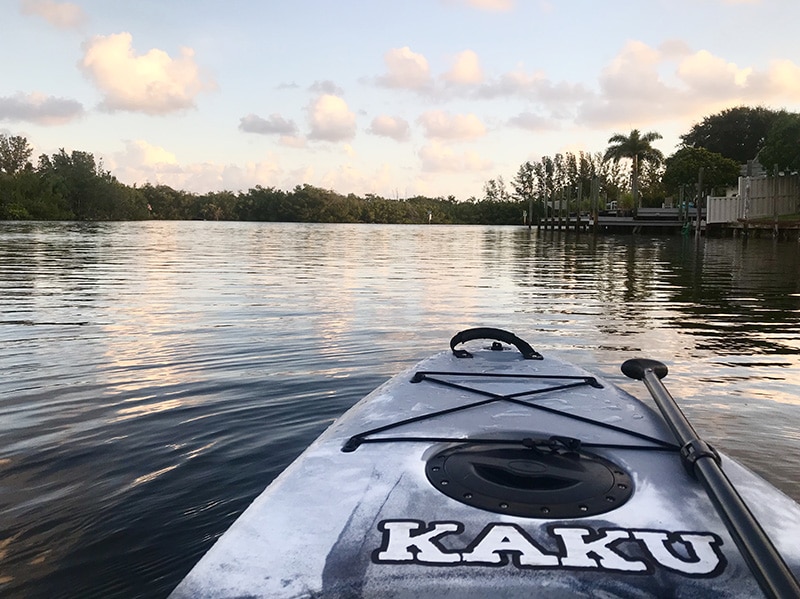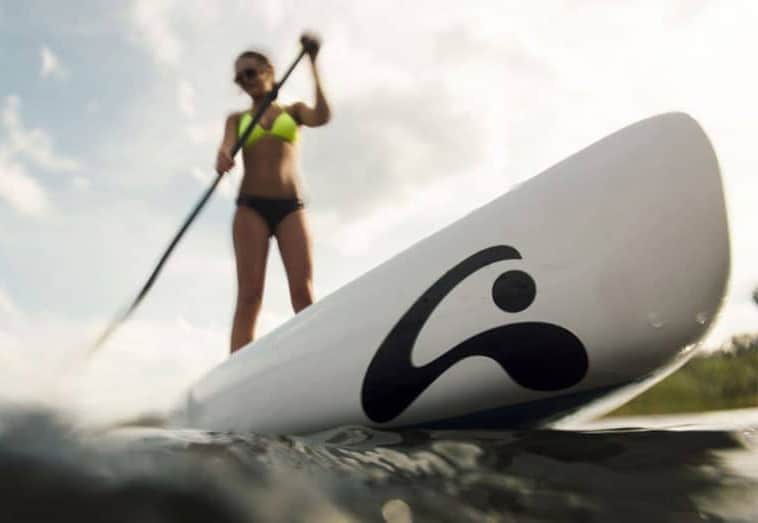Stand-up paddleboarding (SUP) is one of those sports that gets you hooked the first time you try it. Regardless of age or ability, whether you’re doing it for fun or fitness, paddleboarding offers a unique escape for every individual.
That’s why there comes a point in every paddleboarder’s journey when renting a board or borrowing one from a friend just doesn’t cut it anymore.
The next step is learning about buying your own board. To help you along the way, we’ve crafted a list of the most common considerations to make when choosing your first stand-up paddleboard.
Types of Stand-Up Paddleboards
The first thing to consider when selecting a paddleboard is how you’re going to use it. Different types of paddleboards are designed for very different purposes. The most common types of paddleboards for beginners are all-around, surfing, touring, fitness/yoga, and fishing paddleboards.
All-around

All-around paddleboards are a great option for beginners, ranging from 10 to 13 feet long. Sometimes called hybrids, these SUPs feature a combination of characteristics found in all the other types of boards.
All-around boards are very stable and can be used in many different conditions. They’re wide enough to bring a pet and long enough to track well in flat water. They also have a slight curve, so you can even surf with them.
These versatile paddleboards are perfect for you if you’re not sure how you plan on using your board. All-around boards are made for the beginner who wants to try new things.
Surfing
Paddleboards designed for surfing are usually shorter in length. They’re often between seven and 10.5 feet, which makes them easier to maneuver in waves.
Since they’re shorter, they’re also less stable. That means it’s easier to fall off. Surfing paddleboards feature a curve, called a rocker, which makes them handle waves better.
Even if you’re just starting to surf, paddleboards can help you learn. Some surfers even prefer inflatable paddleboards, because they feel safer riding the waves on something soft.
Touring

Touring paddleboards are designed to go long distances in flat waters. These boards glide better on the water, which means more distance traveled with every stroke.
They typically range in size from 11 to 14 feet, and feature a wider deck, allowing you to bring more gear, a pet, or a passenger.
Beginners often choose touring boards if they plan to paddle longer distances or carry a lot of gear.
Yoga (Fitness)
Paddleboards designed for fitness and yoga tend to have the widest and thickest decks. This gives you the most stability on the water and allows you to move around more on the board.
Yoga boards often feature a thicker deck pad, providing a large soft surface to practice your poses. Many beginner SUP yogis prefer inflatable paddleboards, which provide the ultimate comfort during asanas.
Fishing

Fishing paddleboards are the new kid on the block but deserve a mention because they’re ideal for beginners who like to get out there with their rod and reel. You can build your own SUP fishing rig, but recently companies started manufacturing paddleboards specifically designed for the sport.
Fishing SUPs often come with tackle racks, rod holders, paddle holders, and places to tie down a cooler or chair. They’re thicker, wider, and longer, giving you more stability while fishing and more room for your gear. However, this means they can be heavier and more difficult to maneuver.
If you’re mainly using your board to fish, then a specialized fishing board is for you. Otherwise, the other options are lighter and more versatile on the water.
Board Construction
When choosing a stand-up paddleboard, it’s important to consider how your board is made. Board construction will affect the weight of the board and your options for storage and transportation.
Fiberglass/Epoxy

Fiberglass and epoxy paddleboards are the most common and surpass the other types of boards when it comes to performance. Their smooth hulls are designed for better tracking and gliding in different water conditions.
Fiberglass boards are also lightweight, starting at around 25 pounds. One person can easily carry them and load them onto the roof of a car.
There are some downsides to owning a fiberglass SUP. They’re the easiest to damage, and prone to getting dings and nicks. Folks joke that you can scratch a fiberglass board if you look at it wrong.
Like other solid boards, fiberglass boards are tougher to store and transport. They’re also known for being the priciest type of board out there.
Still, despite the downsides, many beginners choose fiberglass boards. Surfing, fishing, touring, all-around, and yoga paddleboards can all be constructed from fiberglass.
Soft Top

Soft top paddleboards are often confused with inflatable boards, but they’re actually very similar to fiberglass and epoxy boards.
These boards are constructed of the same materials as fiberglass boards but feature a deck wrapped in a soft EVA shell.
Soft top boards are pet- and kid-friendly, and you’re less prone to slipping on the spongy deck. They’re comfortable for yoga and fishing, especially if you’re sitting down for long periods of time. They’re also tougher to damage and are more budget-friendly.
Plastic

Plastic paddleboards are made from the same molded plastic as kayaks. That means they’re just as durable as kayaks, which makes them great for fishing and carrying gear.
They’re also perfect for young paddlers since it’s truly difficult to damage these boards. However, the trade-off with plastic paddleboards is their weight.
Starting at 50 pounds, plastic SUPs are harder to transport and load up by yourself. They also lack in performance compared to other solid boards.
Despite the drawbacks, many beginners gravitate to plastic boards because they’re so budget-friendly, starting at just $400.
Inflatable

In a class of their own, inflatable paddleboards offer one huge benefit over solid boards. They’re the easiest to store and transport, rolling up to the size of a sleeping bag.
Inflatable SUPs are ideal if you have a small home, don’t have a roof rack, like to travel with your board often, or plan to hike longer distances to find water to paddle.
They’re surprisingly rigid when properly inflated, and offer virtually the same stability and versatility as solid boards. Although they aren’t the quickest, inflatable SUPs perform well in waves or choppy water.
Hull Shapes
Paddleboards come in two basic hull shapes – planing and displacement. The type of hull you choose will determine how your SUP performs on the water. Both types of hulls can work for a beginner, but it’s important to consider hull shape when thinking about how you’ll use your board.
Planing Hull

Planing hulls are wider and flatter, with a rounded nose, allowing you to cruise on top of the water. They’re more stable and great for surfing, yoga, or all-around paddling.
Displacement Hull

Displacement hulls feature a pointed, V-shaped nose, similar to a kayak. They’re more efficient and slice through the water, pushing the water around the sides of the board.
Because they’re quicker, boards with displacement hulls tend to be less stable. They’re perfect for touring and racing.
Paddleboard Size

Volume, weight capacity, length, and width are important specifications to consider when choosing your first SUP. While getting a board that is too big isn’t a huge issue, buying something too small will make it inefficient and harder to paddle.
Volume and Weight Capacity
The first spec to look at is volume, most often measured in liters. Volume indicates a board’s buoyancy and weight capacity. A higher volume means a SUP can support a heavier rider and more gear. If you have a higher volume paddleboard it will be able to more easily handle your weight.
A board’s weight capacity is often listed in pounds and is the most that the board is rated to carry. If you and your gear are above the weight capacity, your board will sink into the water, making it hard to paddle and maneuver.
Length
Length is important in determining a board’s performance. Longer boards are usually faster, but shorter boards are easier to turn and maneuver.
Longer SUPs starting at 12 feet are ideal for paddling longer distances and carrying more gear. They commonly feature displacement hulls, allowing them to track better on the water. Long SUPs can be difficult to transport and store, especially if you don’t have a garage. They are a more specialized piece of equipment than shorter SUPs.
Short and medium paddleboards range from seven to 12 feet. Most of these boards feature planing hulls, which provide greater stability for a variety of activities. Many beginners start out with an all-around board between 10 and 12 feet due to their versatility.
Width
Paddleboard widths range from about 28 to 33 inches. A wider board provides more stability, while a narrower board is quicker and turns better.
Narrower SUPs are ideal for touring and surfing. The narrower width makes boards more nimble and easy to maneuver. SUPs below 31 inches are quicker, gliding more efficiently on the water. However, narrow paddleboards are less stable and can be tough for a beginner to master.
Wider boards, on the other hand, can help a beginner feel more confident while learning since they’re harder to tip. They’re more suitable for larger riders and have higher weight capacities. SUPs wider than 31 inches are perfect for fishing and yoga, providing all the room you need for your gear or your practice.
Although most beginners start out with a wider SUP, it’s not the right choice for everyone. Smaller riders sometimes struggle to paddle efficiently on wider boards. A narrow board can feel just as stable to a smaller rider and can be a lot easier to carry. It’s important to consider your body type and reach when choosing your first paddle board.
Paddleboard Accessories
Paddle
Some new paddleboards will come with a standard adjustable paddle. These are great for starting out, and will certainly do the trick while you learn. They’re usually made from aluminum or fiberglass.
As you become more advanced, you may decide to upgrade your paddle. Look for a lightweight, durable paddle made of carbon fiber for maximum efficiency.
Personal Flotation Device
In most places, you’re required to wear or carry a personal flotation device (PFD). Many paddlers choose to wear a PFD belt, which is more comfortable and doesn’t get in the way of your strokes.
Leash
They may not look cool, but leashes are an important accessory. If you fall off your board, it will be much easier to recover with a leash, especially if you’re surfing. Paddleboard leashes are longer and designed so that you can move around on your board.
SUP Rack

Once you pick out your new paddleboard, you’ll have to get it home. If you buy an inflatable board, transporting it is no problem. If you have a solid board, then you’ll need some sort of rack to strap it to.
Some people buy specialized SUP racks that mount onto the crossbars of an existing roof rack, but many beginners use pool noodles or foam blocks as padding. A blend of both options is a soft pad rack, design to work with most vehicles. There are many in-depth videos online that show you how to safely secure and transport your new paddleboard.
Choosing your first paddleboard may seem intimidating because it’s such a big investment. Just keep these considerations in mind as you search, and remember that there is a perfect SUP out there for you. How do you plan to use your new paddleboard? Leave a comment below.











